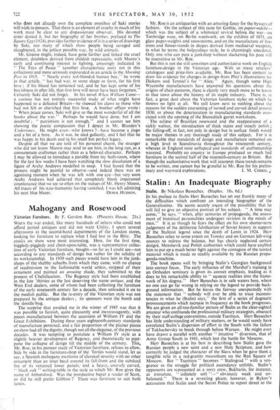A Little Master
The Best of Saki. Selected and with an introduction by Graham Greene. (Bodley Head. 6s.)
HECTOR HUGH MUNRO, who was born in 1870 and died fighting in France in 1916, enjoyed many of the literary predilections of the Edwardian years in which he flourished. He admired FitzGerald's translation of Omar Khayyam and took his pen-name, Saki, from it ; he wrote the best of several Edwardian parodies of Alice in Wonder- land ; he was an assiduous practical joker in the heyday of that not-so-gentle art ; and his short stories show the marked influence of The Dolly Dialogues and of Oscar Wilde, refined; perhaps, by a dash of the paradoxical acerbity. of Samuel Butler. But Munro has triumphantly jumped the boundaries of his period and is still being read and re-printed thirty-six years after his death. Why ? Primarily, I think, for his wit and felicity of phrase. When we read that a woman talked of certain pictures " as growing on one,' as though they were a sort of fungus," or that the voice of another woman was " heavily escorted with exclamation marks," or that the motto of a mouse caught in the nether garments of some unfortunate man " seemed to be Excelsior," we know that we are in the presence of one of those little masters of entertainment who deserve to survive because, in their own line, they are so much better than their num- erous competitors.
An analysis of. the mechanics of Munro's stories reveals his limitations. Being mostly designed for publication in periodicals, they rely over-much on the coup de theatre, while a surprising number are seen to depend upon practical jokes and upon exploits in the Munchausen vein by unprincipled characters resembling Belloc's Matilda (one of his best stories, " The Open Window," is an exam- ple). By way of contrast, he employs another recipe which brings him sharply to the macabre, as in " Sredni Vashtar," the story of a ferret incited by an unhappy little boy to kill his objectionable guardian— or " The Wolves of Cernogratz," which Mr. Greene has omitted from the present selection. Earlier commentators have related Munro'', cruel strain to his own miserable childhood spent in the house of his maiden aunts—ane‘Mr. Greene again stresses the point in his interesting introduction to The Best of Saki, a book which everyone
who does not already own the complete omnibus of Saki stories will wish to possess. That there is an element of cruelty in much of his work must be clear to any dispassionate observer. His devoted sister denied it, but her biography of her brother, prefaced to The Square Egg (1924), provides further evidence of it in a series of drawings by Saki, too many of which show people being savaged and slaughtered, in the jolliest possible way, by wild animals.
Mr. Greene might, indeed, have gone further and linked the cruel element, doubtless derived from childish repressions, with Munro's early and continuing interest in fighting, amusingly indicated in " The Toys of Peace " (another characteristic story not in this collection) and more seriously expounded in an article in the Morning Post in 1915. " Nearly every red-blooded human boy," he wrote in that article, " has had war, in some shape or form, for his first love ; if his blood has remained red, and he has kept some of his boyishness in after life, that first love will never have been forgotten." Certainly Saki did not forget. In his novel When William Came— a curious but not entirely successful study of what might have happened to a defeated Britain—he showed his claws to those who had not felt or cherished that first love. A brother officer wrote : " When peace comes, Saki will give us the most wonderful of all the books about the war." Perhaps he would have done, but I am doubtful ; " patriotism is not enough," and I cannot see him showing the poetic compassion that I detect in Mr. Blunden's Undertones. He might even—who knows ?—have become a jingo and a bit of a bore. As it was, he died gallantly, and 1 feel that he was happy in his death and iq his small but perfect legacy.
Despite all that we are told of his personal charm, the stranger who did not know Munro may tend to see him, in the long run, as a consummate craftsman rather than as a beloved character. Perhaps I may be allowed to introduce a parable from my bath-room, where for the last few weeks I have been watching the slow dissolution of a figure of Archy Andrews modelled in soap. I had feared that the process might be painful to observe—and indeed there was an agonising moment when he was left with one eye—but very soon Archy Andrews had achieved that completely blank impersonal countenance that we see so often on the statues of Mr. Henry Moore. All traces of his near-humanity having vanished, I was left admiring











































 Previous page
Previous page